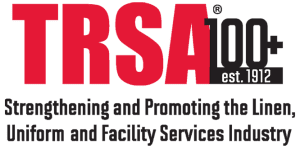TRSA, Europeans Weigh Certification Upgrades
Click Here for Info on TRSA’s Healthcare Conference
TRSA’s Hygienically Clean Advisory Council will convene in September to consider upgrades to the textile services certification programs it oversees, examining further opportunities to validate processes and quantify outcomes for launderers serving healthcare, food safety, food service, hospitality and other businesses.
 Compliance with Hygienically Clean standards requires textile services to adhere to best laundry practices and microbial content limits on cleaned textile products before delivery to customers. TRSA introduced routine microbial testing protocols to the North American laundry industry when it launched the Hygienically Clean program in 2011 and pledged to continuously improve standards.
Compliance with Hygienically Clean standards requires textile services to adhere to best laundry practices and microbial content limits on cleaned textile products before delivery to customers. TRSA introduced routine microbial testing protocols to the North American laundry industry when it launched the Hygienically Clean program in 2011 and pledged to continuously improve standards.
As the world’s largest association of textile services operations, TRSA’s connectivity to laundry professionals is unmatched, providing the certification programs with unparalleled access to emerging best practices and technologies.
In the current review, the Advisory Council is considering upgrades largely related to adding Critical Control Points (CCPs) to the Hygienically Clean Healthcare and Hospitality designations. CCPs are the steps in a process that pose higher biocontamination risk than others. Compliance requires a description of how such risk is controlled (eliminated or reduced). For example, washing often is considered a CCP. Risk is controlled in large part by inspecting proof-of-delivery reports generated by systems that inject liquid detergent into washers according to set formulas, while also monitoring the use of these formulas.
CCPs are part of TRSA’s Hygienically Clean Food Safety certification. They address high demand from food manufacturers and processors for their suppliers to deploy hazard analysis and CCP (HACCP) concepts. HACCP also is incorporated into the Hygienically Clean Food Service standard to address restaurateurs’ concerns regarding their supplies’ hygiene as restaurant patrons grow more concerned about cleanliness practices in these facilities.
Members who serve on the Hygienically Clean council, mostly launderers, but including representatives of healthcare and academic professions, are considering how various washing, drying and finishing systems and functions might factor into CCPs. Controls might include additional microbial content testing of:
- Textiles at various stages of laundry processing, not just immediately before delivery
- Wash water
- Hard surfaces of machinery, storage and carts
Hand hygiene requirements are also being weighed.
The council’s deliberations coincide with national standards-setting bodies in Europe deciding how they will modify new continentwide laundry protocols to address their countries’ specific hygiene concerns.
Earlier this year, the Textiles and Textile Products technical panel of the European Committee for Standardization (CEN) revised EN 14065, improving the standard’s guidance of laundries in establishing their own risk analysis and biocontamination control (RABC) processes. Individual nations’ CEN affiliates and their respective certifiers can add provisions to the Europewide standard similar to the Hygienically Clean requirements. Aug. 31 is CEN’s deadline for its national affiliates to present EN 14065 to their constituencies.
Neither TRSA’s standard nor EN 14065 stipulate which steps in a launderer’s process must be declared CCPs. Both call for CCPs to be applied, however, with EN 14065 now distinguishing between basic control points (any step requiring control) and critical ones.
“Hygienically Clean’s approach of requiring launderers to apply general best practices but not mandating specific techniques fits well into the EN 14065 model,” said TRSA President and CEO Joseph Ricci. “Including HACCP in certification requirements without stipulating every detail of its implementation recognizes that launderers, supported by their suppliers, are most qualified to identify contamination risks in their own operations and address them properly.”
Hygienically Clean specifies microbial content levels for laundered textiles and laundry work surfaces without dictating the tactics to achieve them. The recent European standard revision “continues to offer a framework and does not define specific hygiene levels,” leaving that function to certifiers, said Robert Long, secretary-general, European Textile Services Association. Key additions besides CCPs, he says, include quantitative risk analysis (upgraded from semi-quantitative) and improved definitions of process validation, verification and monitoring.
“As before, the standard does not contain any specific requirement levels, leaving a lot of flexibility in terms of how principles are applied,” said Eoin Flavin, the U.K.-based member of TRSA’s Hygienically Clean Advisory Council who directs wash chemistry supplier Washing Systems Ltd.’s European operations. “We continue to need this flexibility to cater to different requirements in different sectors and countries.”
The TRSA council is slated to meet next month and again in November at the TRSA Healthcare Conference. The Hygienically Clean Users Group also will meet there. The conference will feature a presentation on applying HACCP to the healthcare laundry sector, explaining how it guides risk identification and otherwise protects healthcare customers and laundry plant employees. The TRSA members-only conference takes place Nov. 30-Dec. 1 in Nashville, Tenn. Click here to learn more or to register.
